TSUBA COLLECTIVE
FOR SALE

TSUBA COLLECTIVE
FOR SALE

|
ROBERT E. HAYNES & ELLIOTT D. LONG |
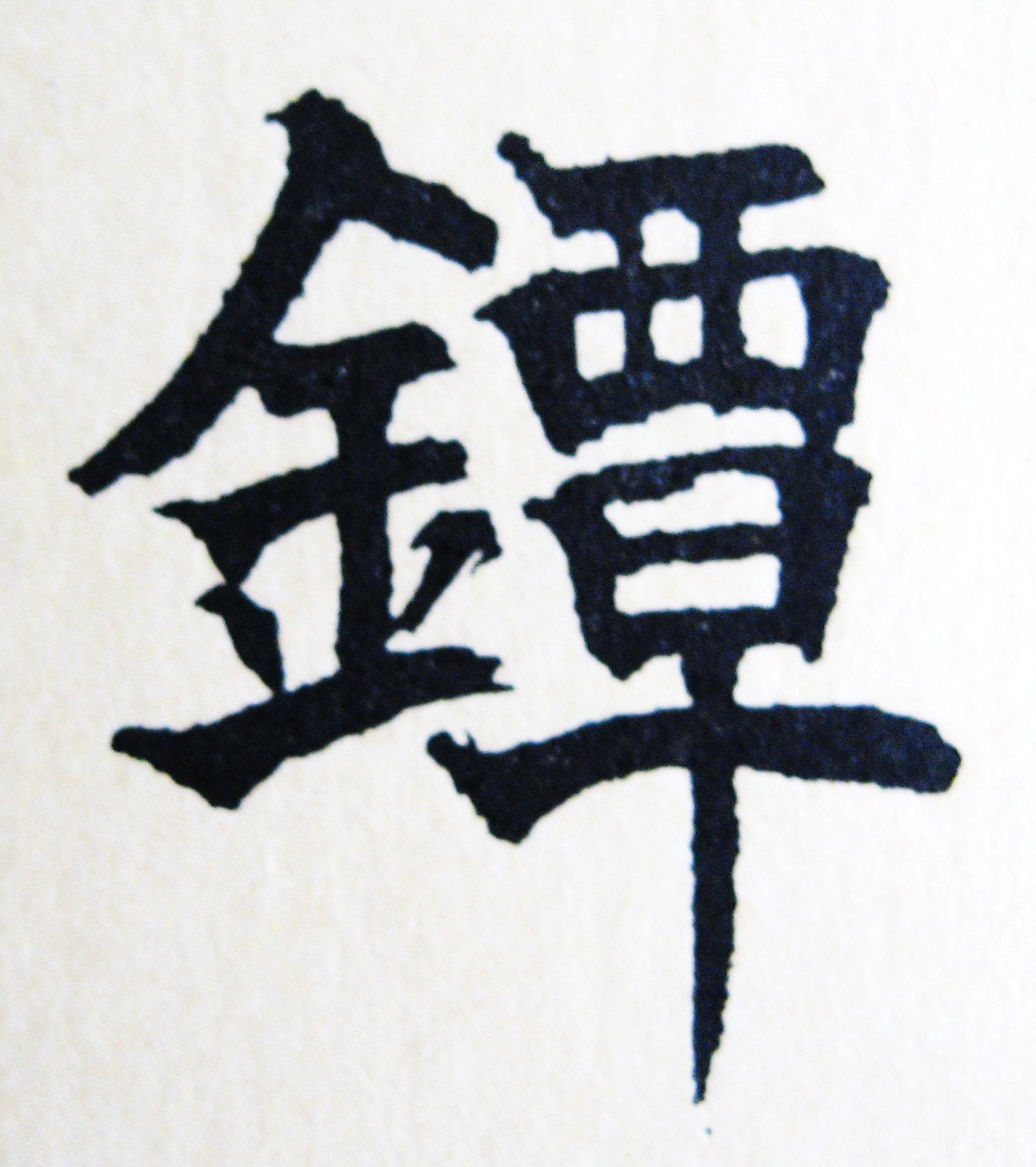 |
IRON TSUBA --> AKASAKA ~ BUSHU/CHOSHU ~ GOTO ~ HAZAMA ~ HEIANJO ~ HIGO ~ JAKUSHI-HIZEN ~ KAGA ~ KAGAMI-SHI ~ KAMAKURA-BORI ~ KANAYAMA ~ KANEIYE ~ KINAI/AKAO ~ MINO ~ MITO ~ MYOCHIN ~ NISHIGAKI KANSHIRO ~ NOBUIYE ~ ONIN ~ OWARI to MIKAWA ~ SANKEI ~ SAOTOME - TEMBO ~ SHIMIZU (Jingo) ~ SHOAMI ~ SHOKOKU ~ SOTEN ~ SUKASHI ~ TACHI KANAGUSHI ~ TANKO (KATCHUSHI & TOSHO) ~ UMETADA ~ YAMAKICHIBEI
SOFT METAL (KINKO) TSUBA --> JOEI ~ JOI ~ KANRI ~ KIYOSADA ~ KO-KINKO ~ MITSUNAGA ~ MOTOTADA ~ NAGATSUNE ~ SEKIBUN ~ SHIGENORI ~ SOCHI ~
TANKO (KATCHUSHI & TOSHO)
| KO - KATCHUSHI $6000.00 "Large square iron plate nicely forged and hammered with excellent patina and color. Further study and description coming soon." (Haynes & Long) | |
| KATCHUSHI $1700.00 "Presented here is a well forged iron plate in a gourd shape with Kotoru rounded edge. Both surfaces are expertly hammered. Eggplant sukashi at the lower quarter. This workmanship creates an indescribable atmosphere. Further study and description coming soon Attributed by NBTHK Tokubetsu Kicho (Green) Origami. Dated May 13, 1972." (Haynes & Long) | |
| KO-TOSHO $3000.00 "Very large, powerful Tosho tsuba, nicely forged and hammered with excellent patina and color. The hitsu-ana is original to the tsuba which was made prior to the Edo period. Sukashi of two interlocking rings having a Buddhist symbolism meaning Unity of Strength and Love, Mind and Body. Very important to the Samurai." (Long) | |
| KATCHUSHI $1500.00 "The bright quality of this symetrical group of snowflakes and stars is not typical of katchushi guards. Although the plate has an old look, the intelligent and skillful nature of the open work suggests that this is not among the earliest guards. In all likelihood, it belongs to the middle or late Muromachi period. The design is excellent and carefully worked out." (Long) 8.30cm x 8.30cm x 0.51cm (rim) x 0.36cm (face) | |
| KATCHUSHI $2000.00 "Masterpiece Ko Katchushi tsuba with dote mimi, iron thin plate. The rim is peculiar to armorer's tsuba. Also, if you look closely at this background, there is a thin inlay, which seems to have been added later. Perhaps, it is considered that the samurai who inherited the tsuba later carved a pattern like a family crest inlay. The sukashi openings represent the moon and its reflection, and a star?" (Long) |
MYOCHIN HA
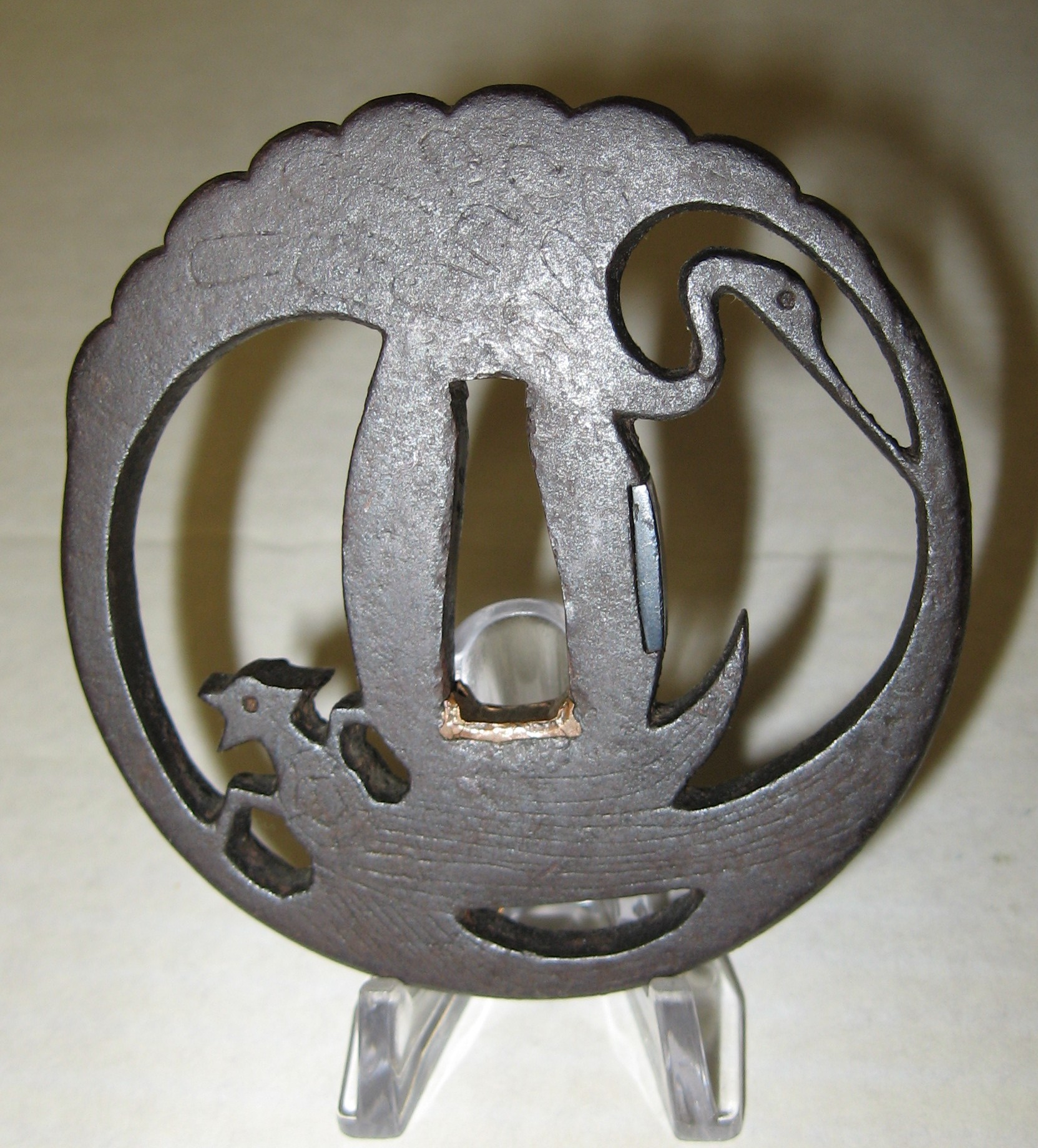 |
KAGA MYOCHIN $1200.00 "In this case the plate is very thick, more than the thickest Akasaka school plate. This example would seem to be the work of the Edo period Myochin school. The original Horai school was related to the Kaga Myochin group, and this example was probably made by a later master of that school. The plate has a very fine patina and the edge has some iron bones. There is fine line carving detail on both the crane and the tortoise (crane and tortoise emblematic of longevity). It would seem that this tsuba was made to emulate the original Horai examples, of the Momoyama period, some of which are signed." (Long) 7.9cm x 8.0cm x 0.7cm. thick |
  |
'MYOCHIN NAGATO no KAMI FUJIWARA KUNIMICHI' $1000.00
"Hammer mark pattern on well-tempered iron ground, maru gata, with bamboo pattern carving. Mei: 'MYOCHIN NAGATO no KAMI FUJIWARA KUNIMICHI'. This is H 03612.0 in the Haynes Index. A tsuba craftsman working in Kanda in Edo ca. 1700-1750." (Haynes & Long) 7.65cm x 7.57cm x 0.40cm |
  |
'MUNEHIRA' $800.00
"A round iron tsuba with inlays of a dragon and folage design. A wonderful example of this tsubaco's work. Signed: 'MUNEHIRA'. Refer to Haynes Index H06063.0." (Haynes & Long) 7.90cm x 7.90cm x 0.50cm |
  |
'SHIGENOBU' $800.00
"Iron plate with rope styled shakudo fukurin. The three openings depict clouds possibly. Both hitsu kogai shape. Signature: 'SHIGENOBU'. This is the Myochin Shigenobu who worked in the Kozuke Province." (Long) 7.65cm x 7.70cm x 0.35cm |
|
ONIN $1000.00 |
|
|
HEIANJO Tsuba $1700.00 |
|
|
EDA KIKU ZU |
|
|
SENDAI (Heianjo) |
|
|
HEIANJO EGGPLANT |
KYO-SUKASHI, HEIANJO/ SUKASHI
|
KYO-SUKASHI $2200.00 |
|
|
SUKASHI Tsuba |
|
|
SUKASHI Tsuba |
|
SUKASHI $200.00 |
BIZEN SHOAMI $8000.00 |
|
'TENKA CHUKO KAISAN SHOAMI JIROHACHI' |
|
'TENKA CHUKO KAISAN SHOAMI HIROYOSHI' |
|
| KO-SHOAMI $1200.00 "Presented here is a early Shoami tsuba around the late Muromachi/early Momoyama period (ca. 1550). In terms of era division, the Northern and Southern Courts, Muromachi, Sengoku, and Momoyama periods were traditional for Katchushi and Tosho style tsuba. This is a very bold, strong plate of well forged iron. The iron base has hammer marks as a whole, and the rim is square and stout. The sukashi openings represent a sake cup and gourd." (Long) | |
|
AIZU SHOAMI |
|
  |
|
  |
Ko-Shoami $1600.00 "Write up to follow. NBTHK 'GREEN' paper attribution." (Haynes) 8.90cm x 8.60cm x 0.40cm |
  |
KYO-SHOAMI $800.00 A marugata niku bori ji sukashi tsuba depicting a table used on an alter of a temple to place offerings on top of. The entire surface of both sides and rim are smooth, made first by filing and then by the use of a whetstone. Dates to ca. 1700. (Long) 7.32cm x 7.33cm x 0.56cm |
 |
KO-SHOAMI $500.00 "Iron square mokko shape (iri-sumi kaku) of sukashi design of a kanji meaning 'for you'. This was a gift tsuba. Remnants of gold and silver inlay, gold representing the sun and silver representing the moon. A fair amount of the inlay is missing but cherry blossom flowers can be seen. Dates to Momoyama period, ca. 1700." (Long) 7.90cm x 8.15cm x 0.45cm |
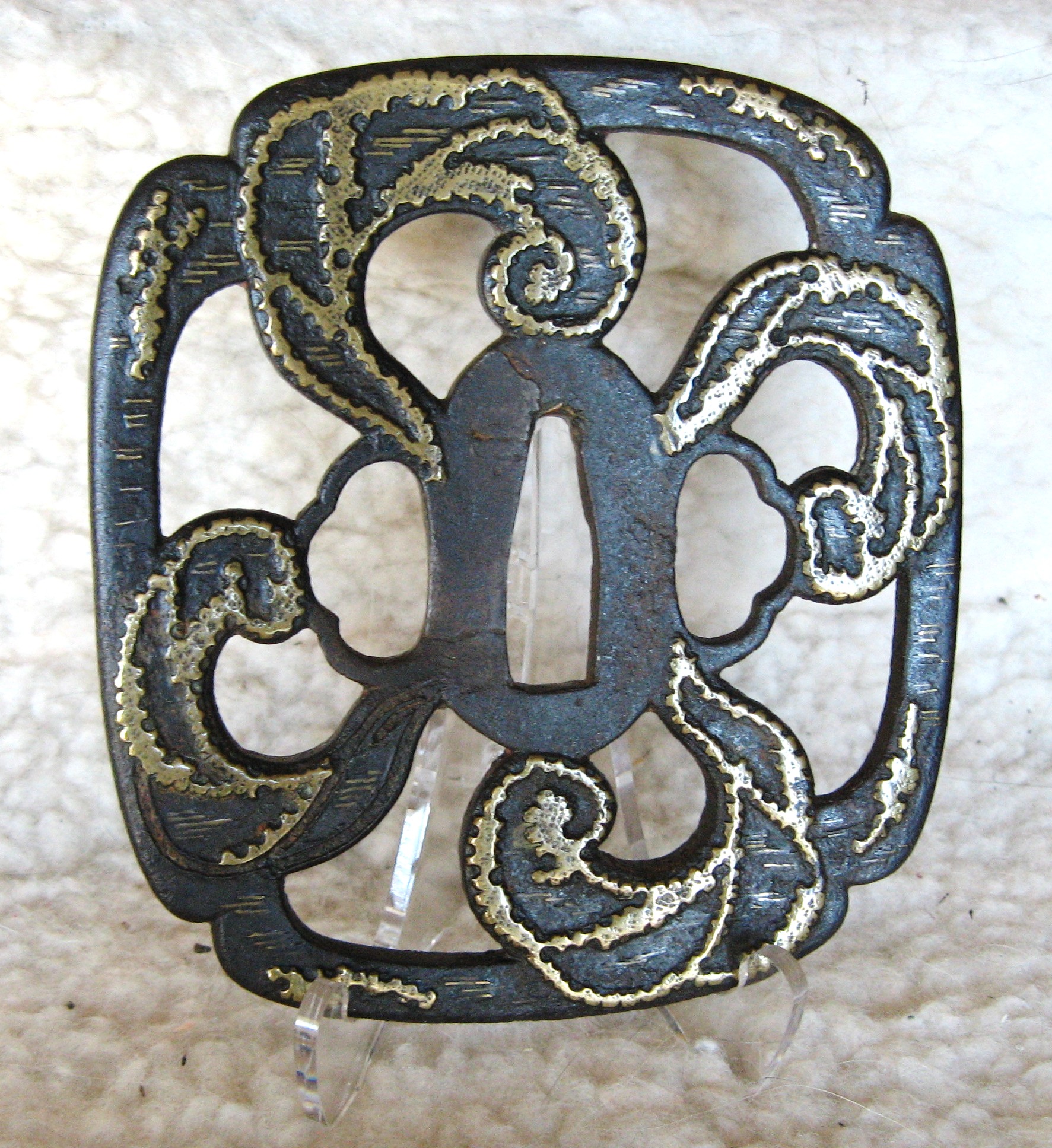  |
SHOAMI $1000.00 Momoyama Period (ca. 1600) "The elaborate and detailed design of cloves, the use of refined iron with abundant brass inlay, contribute to the strong impact of this masterpiece. There seems to be two different colors of brass inlay used. Fine tekkotsu on the rim. The representation seen here of cloves (one of the objects of the Takaramono, associated with the Gods of Luck), define Sweetness and Health. Only missing inlay at 8 o'clock position (see at right)." (Long) |
 |
AIZU SHOAMI $300.00
"Aizu Shoami tsuba mostly have an iron ji, and kinko works are very rare. The shinmaru gata (true circle) shape is encountered regularly. Most round tsuba are a bit taller than they are wide as is the case here. Both hitsu-ana are often shaped like kogai-hitsu as opposed to the standard kozuka kogai configuration. A motif showing a person or thematic object with a natural landscape in the background is common. Motifs such as the Chinese subject shown here, are often seen. The bottom right section will contain the main design carved in takabori and/or detailed with nunome or inlay work, while the upper left section area is carved with comparatively less detail - moresoft and suggestive. This effect implies visual distance, draws our eye to the main section of the work and gives the illusion of depth to the overall design." (Long) 6.90cm x 7.35cm x 0.40cm |
 |
SHOAMI $600.00
"A round iron plate tsuba with scalloped rim edge. The brass inlay of three leaf plant with vines occurs on both sides. On the ura side, left of nakago-ana, is carved 'Ten' meaning heaven, sky, the air, Imperial, etc. It seems this was added after the tsuba was made. The hitsu-ana show Shoami style influence. Dates to the Momoyama period, ca. 1550-1600." (Long) 7.30cm x 7.85cm x 0.45cm |
KANEIYE TSUBA
 $450.00 |
 $400.00 |
 $300.00 |
 $900.00 |
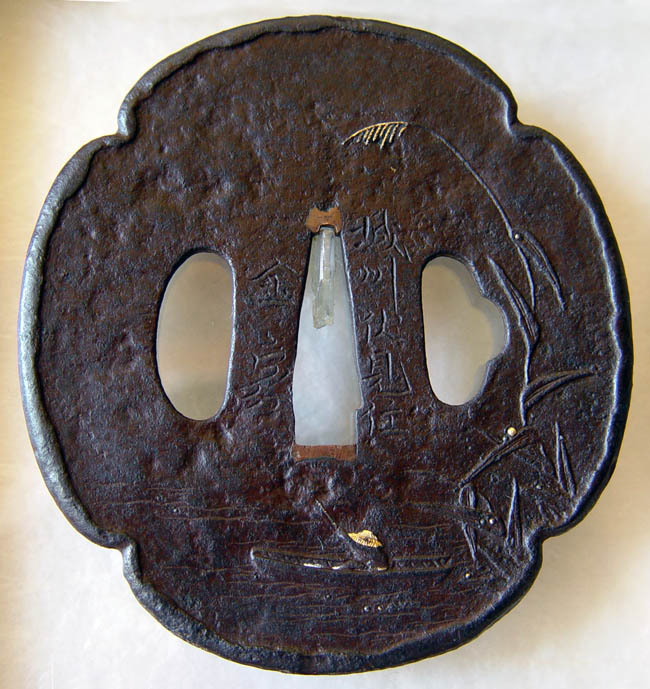 $1000.00 |
 NFS |
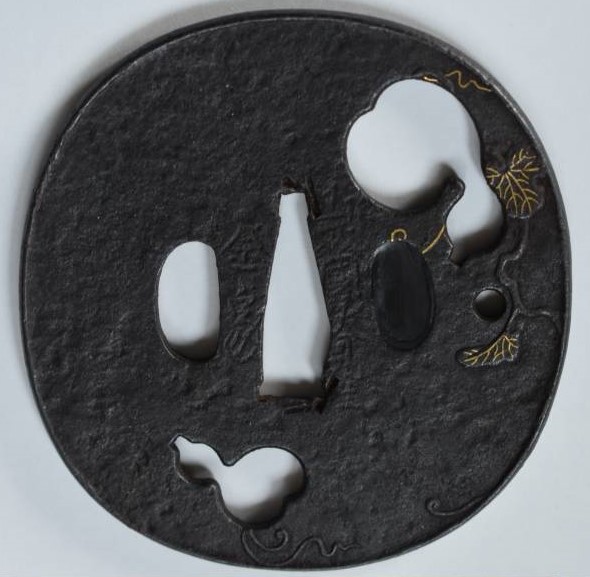 $5200.00 |
 $2000.00 |
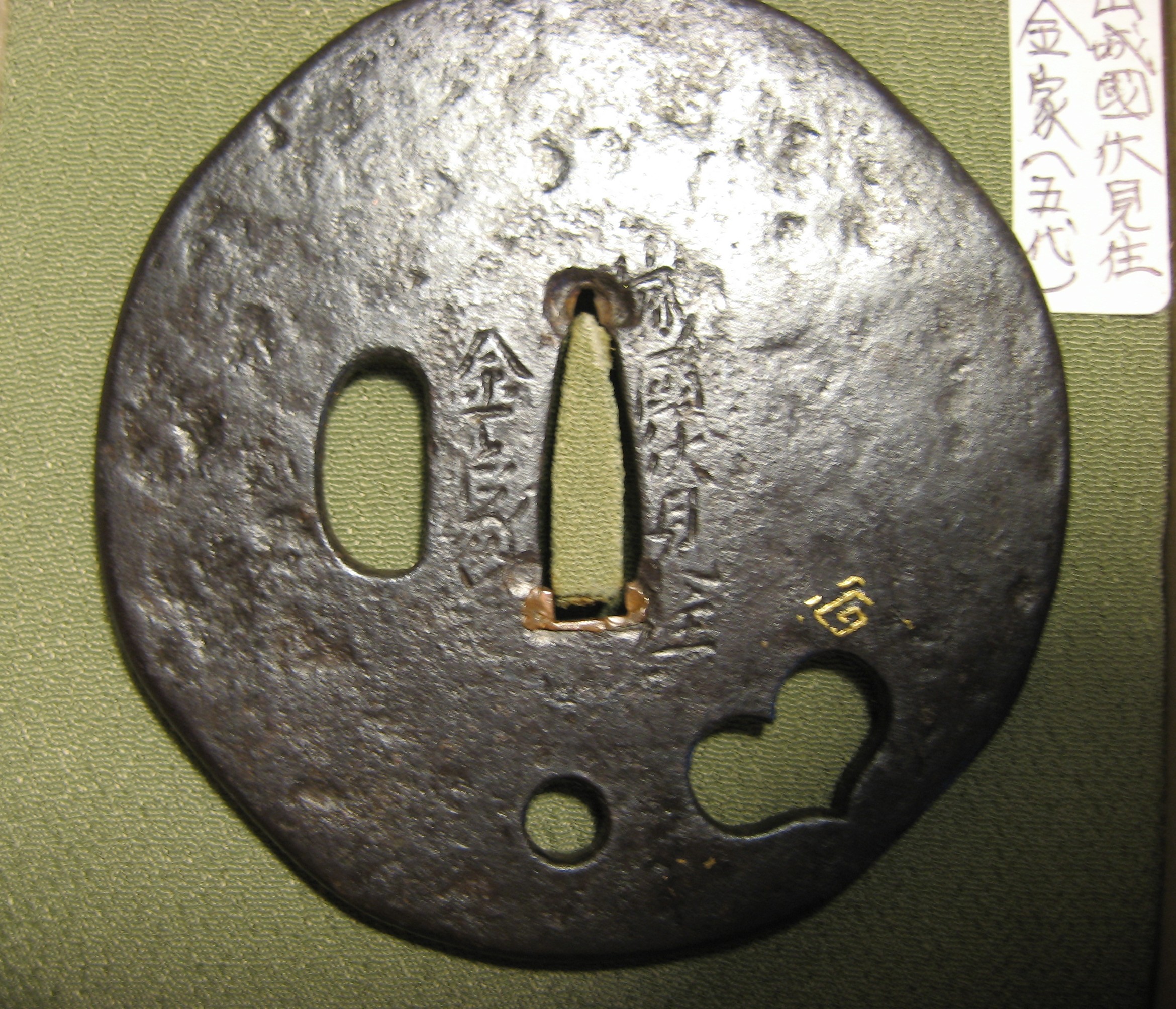 $1200.00 |
 NFS |
NOBUIYE Tsuba
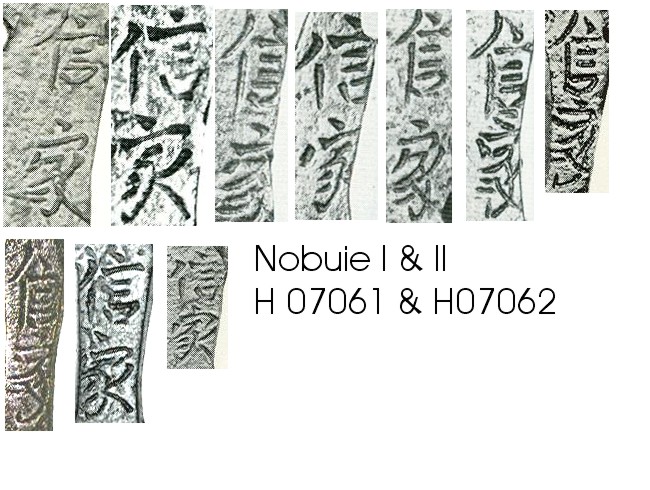
Among his tsuba with various types of mei, there are a small number of katchu-mei (armor maker’s signature) pieces. These signatures have the same characteristics as those on his armor and the tsuba styles are slightly different. Upon examination of the shosaku (genuine work) of Nobuiye, these should be attributed as his own and all other mei-furi (appearance, or style of signature) pieces as those of his disciples. There is a distinction among the daisaku (ghostwriting; a stand-in; double) work; mei is separated with ko-sukashi and kikka uchikomi (chrysanthemum pattern hammered in), and there are other signatures with many kikko (tortoise shell) patterns, many with monji (Japanese written characters) designs, and some with jimon (patterned surface). To copy a style, one should try to create an extremely believable work. These Nobuiye have various mei-furi (style of a signature) with no evidence of copying, they all endeavor to demonstrate their skill. Perhaps it is closer to the truth to see them as daisaku (a stand-in; double).
 |
'NOBUIYE' $1200.00 "A round plate that is well hammered in true Nobuiye style with uchikaeshi rim. Kiri mon hot stamp appears at the same cross points on both sides. Almost all of the original black lacquer is intact with the exception of a few small areas. Signed: 'NOBUIE' H 07061.0. This is a masterly example of a Shoami Nobuiye tsuba. The shapes of the hitsu-ana and the surface treatment confirm a date of ca. 1500." (Long) |
 
|
'NOBUIYE' $2500.00 H 07072.A "Owari Nobuiye, H 07070.0 dates to 1700-1750. Sato Kanzan hakogaki 1963" (Long) 7.70cm x 7.10cm x 0.35cm |

|
HIZEN 'NOBUIYE' $2500.00 H 07072.A "Katana size iron mokko plate tsuba with the web carved in low relief of a male dragon in clouds. The seppa-dai is in the shape of the "Chinese" style often seen on the tsuba made in Hizen Province at the city of Nagasaki. The face is signed 'NOBUIE', in two large kanji. This style of the Nobuie signature does not match any of those recorded so far. It would seem this is an unrecorded Nobuiye who was living in the Hizen/Nagasaki area in the mid to later Edo period." (Long) 8.50cm x 7.50cm x 0.60cm |
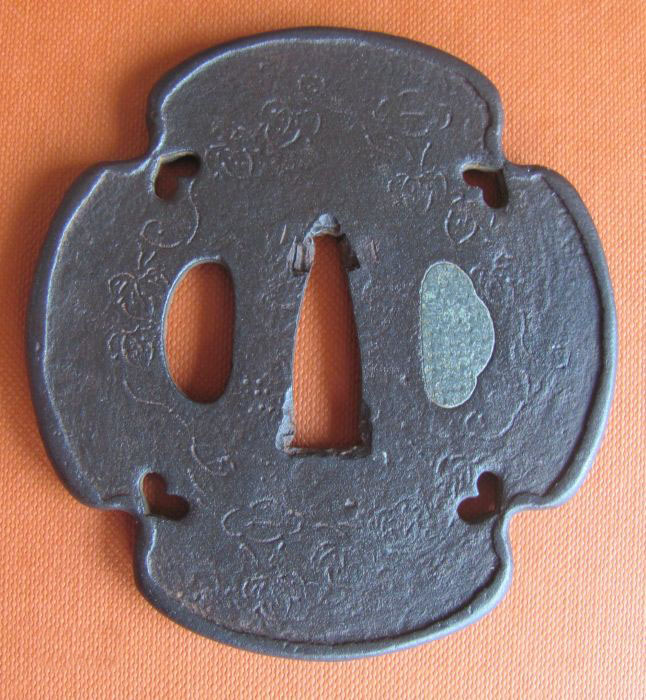
|
MYOCHIN NOBUIYE $1200.00 H 07075.0 (ca. 1550) "This artist worked in Shiroi in Kozuke Province who made helmets and signed them with his full signature. Wakayama vol. II p. 294 has 3 examples of these signatures. They are a good comparison to the Nobuiye signature found on tsuba. Dense well-forged iron plate (kurikomi-mokko-gata) with ample tekkotsu on the mimi." (Long) |
 |
'NOBUIYE' $1200.00 "Echizen Nobuiye, H 07064.0 dates to ca.1650-1700." (Long) |
 |
'NOBUIYE' $1000.00 "A small iron plate with the cherry blossom and omodaka design of Nobuiye's. There are vestiges of the NOBUIYE signature, only the first kanji is visable." (Long) |
  |
'MINAMOTO no YOSHIYUKI' $800.00 "Worked in the style and made copies of Nobuiye school tsuba. Large rounded square iron plate tsuba with raised rim, the plate carved with the classic tortoise shell pattern found on many Nobuiye tsuba. The plate surface well worked and showing the forging patterns that are famous in Nobuiye tsuba. The hitsu-ana are both kozuka shaped, one a little larger than the other. Mei: 'MINAMOTO no YOSHIYUKI'. See Haynes Index H 12327.0." (Long) |
 |
SHOAMI 'NOBUIYE' $500.00 H 07069.0 (Hosoji-mei) (ca.1750-1800) "This artist was one of the last to use the Nobuiye name. He worked in Sanshu Okazaki ju, Mikawa Province using mostly the kinko style and did not make any Kiyosu Nobuiye tsuba." (Long) |
 |
'IWAI YOSHIMICHI' $2000.00 "Well hammered iron plate in 'nade mokko gata' shape. Nobuiye and other early tsuba makers used this shape which, when mounted on a sword, is even more striking in appearance than as a separate piece. Its gentle curved shape has a feminine quality, reminding some of 'otafuku' or of 'okame' shapes and such were consequently called by these terms. This shape was also called 'tate mokkogata' and 'nade mokkogata' in Edo. The raised rim was formed by being beaten from both the outer circumference inward, and from the inside of the rim flange outward, known as 'uchikaeshi mimi'. Mei: 'IWAI YOSHIMICHI' H 11831.0. Made in the style of Nobuiye (H 07061.0) about ca. 1800. Art name Seiryusai. Worked primarely in Edo." (Long) |
 |
'NOBUIYE' $2000.00 H 07074.0 (ca.1600-1650) "There are examples of the Nobuiye signature that have come to be called, the 'wide spaced signature', these tsuba are signed just Nobuiye, but the kanji are carved at the top and bottom of the seppa-dai area. Possibly the work of two different artists and their relationship to the Kiyosu Nobuiye is not known, but the quality of their work is very close to that of the Kiyosu group." (Long) |
 |
'NOBUIYE' $3000.00 H 07074.0 "Large oval mokko iron plate tsuba with raised rim, the edge and the plate carved with the classic tortoise shell pattern found on many Nobuiye tsuba. The plate surface well worked and showing the forging patterns that are famous in Nobuiye tsuba. The hitsu-ana are in the form of the Matsukawabishi mon, half forming each side. All these elements are repeated on the reverse side. The face is signed: 'NOBUIYE', see H 07074.0. This is a new, unrecorded example of what I have called the "wide spaced" Nobuiye signature." (Long) |
YAMASAKA KICHIBEI YAMAKICHIBEI YAMAKICHI
|
'YAMAKICHIBEI' $2500.00 | |
|
'YAMAKICHIBEI' $3000.00 |
|
OWARI School. $2500.00 | |
|
OWARI $2000.00 | |
|
OWARI $600.00 | |
|
OWARI $1500.00 | |
|
OWARI $900.00 |
|
HAZAMA |
|
|
HAZAMA |
|
|
HAZAMA |
  |
'ECHIZEN JU KINAI SAKU' $1500.00
7.65cm x 7.64cm x 0.54cm (seppa) "Kinai tsuba for wakizashi, maru gata, dote mimi, kozuka and kogai ana are filled. Katachi bori sukashi design of a single aoi leaf shaped to be rounded, convex on ura and concave on omote. Ura mei “Echizen no Ju” “Kinai Saku”, probably Yondai Takahashi, late 1700’s."(Long) |
|
"ECHIZEN JU" "KINAI SAKU" |
 |
GOTO Den $4000.00
6.25cm x 5.55cm x 0.70cm (seppa) "It is the Hinode Tsuru figure tsuba that was identified as Goto Den, though it was unnamed. The workmanship is classified as mokko shape shakudo with fine nanako ground and takabori with iroe ornamentations resembling that of Goto Jujo. The carvings as the iroe are very delicate and result in a finely detailed and elegant style."(Long) |
 |
BIZEN YOSHIRO Tsuba $3000.00 "An excellant example of a unsigned Bizen Yoshiro tsuba. The inlay is excellant and even extends over the edge of the eight-petal chrysanthemum area. The design between the mon are bamboo stems. Dates to the Muromachi period, ca. 1400." (Haynes & Long) 7.90cm x 7.90cm x 0.40cm |
  |
YOSHIRO Tsuba SOLD "Presented here is a fine example of a YOSHIRO tsuba. In Edo this name applied to all brass inlaid tsuba with floral designs. Yoshiro tsuba originate from the Heianjo-zogan school and are not of independent origin. The term Yoshiro is but part of the name of Koike Yoshiro Naomasa. Naomasa worked about the Keicho era (1596-1614). The plate metal is iron of good quality and hardness like Heianjo-zogan work. The forging is very good. As seen here, the iron quality is good with the most admirable quality being the fine brass inlay making the contrast very elegant. An exemplary example of a YOSHIRO tsuba." (Haynes & Long) |
  |
KAGA YOSHIRO Tsuba POA "A well forged iron plate with eight roundels - circular emblems of family crests (mon) made of cast brass, pierced and chiseled in kebori, and with flat brass inlay (hira-zogan) of bamboo stems between each pair of mon. There are eight different kamon in sukashi, which are obviously visible on both sides. These sukashi sections that are inlaid into the plate are refered to as ranma-bori because they have the appearance of the ranma (transom panels with openwork carving) that are seen in Japanese temples and other important buildings above walls and doorways. Dates to ca. 1450." (Haynes & Long) 7.95cm x 8.01cm x 0.30cm |
  |
KAGA YOSHIRO Tsuba POA "A well forged iron plate with five roundels - circular emblems of flowers and/or family crests (mon) made of cast brass, pierced and chiseled in kebori, and with flat brass inlay (hira-zogan) of stems. This inlay style is Kaga Yoshiro zogan where the brass is inlaid into channels and then filed back to be flush with the surface of the iron plate. The hitsu-ana are outlined in brass. There are five different kamon in all on both sides. All kamon are in sukashi, which are obviously visible on both sides, are of various daimyo families. These sukashi sections that are inlaid into the plate are refered to as ranma-bori because they have the appearance of the ranma (transom panels with openwork carving) that are seen in Japanese temples and other important buildings above walls and doorways. Dates to the end of the Muromachi period, ca. 1500. Accompanied with a Hakogaki by Sato Kanzan" (Long) 8.15cm x 7.85cm x 0.35cm |
  |
BIZEN YOSHIRO Tsuba $3600.00 "A maru-gata and maru mimi tsuba of well forged iron plate with six roundels - circular emblems of flowers and/or family crests (mon) made of cast brass, pierced and chiseled in kebori, and with flat brass inlay (hira-zogan) of vines with flower buds. This inlay style is Yoshiro zogan where the brass is inlaid into channels and then filed back to be flush with the surface of the iron plate. All inlay is present with the exception of four very small pieces. The rectangular hitsu-ana is original as is the kozuka-ana that is outlined in brass. Note the thickness of the sekegane in nakago-ana. There are six different kamon in all on both sides. All kamon are in sukashi, which are obviously visible on both sides, are of various daimyo families. These sukashi sections that are inlaid into the plate are refered to as ranma-bori because they have the appearance of the ranma (transom panels with openwork carving) that are seen in Japanese temples and other important buildings above walls and doorways. Appears to be Mumei but if close study under good light there are vestiges of a mei belonging to SABURO DAIYU. Dates to ca. 1500-1550. This is 100 years earlier than Naomasa." (Long) 8.10cm x 8.30cm x 0.30cm |
 |
'SABURODAIYU' $8000.00 "This is the flush brass inlay artist often with designs of brass sukashi family mon with vines and tendrils with flower buds on the iron plate. Dates to Momoyama period, ca. 1500-1550. A very fine 1st class example of 'SABURODAIYU' of the Koike family. Worked in Okayama in Bizen Province. Refer to H 07660.0 in Haynes Index. Close relationship with Koike Yoshiro (H 06677.0) group. |
  |
KOIKE YOSHIRO Tsuba $6000.00 "A well forged iron plate with six roundels - circular emblems of family crests (mon) made of cast brass, pierced and chiseled in kebori, and with flat brass inlay (hira-zogan) of tied bundles of plants separating each mon. There are six different kamon in sukashi, which are obviously visible on both sides. These sukashi sections that are inlaid into the plate are refered to as ranma-bori because they have the appearance of the ranma (transom panels with openwork carving) that are seen in Japanese temples and other important buildings above walls and doorways. It should be noted that these MON represent familys living in the Northern area of Japan. Dates Momoyama period, ca. 1600-1650." (Haynes & Long) |
  |
HOKORU YOSHIRO $4000.00 "A large rounded square iron plate with gold inlay defined as 'Hokori Yoshiro.' Dr. Torigoye labeled this type of inlay as 'gomoku zogan' or trash inlay. There appears on both omote and ura three or four family mon, one being the Hosokawa Mon. A 1st Class example of this very rare style of zogan inlay and design. Dates to ca, 1600. A great deal more study is needed."(Haynes & Long) 8.00cm x 7.50cm x 0.45cm |
  |
'YOSHIRO' $2000.00 "Presented here is a fine example of a YOSHIRO tsuba dating to the late Muromachi period. Yoshiro tsuba originate from the Heianjo-zogan school and are not of independent origin. The term Yoshiro is but part of the name of Koike Yoshiro Naomasa. The plate metal is iron of good quality and hardness like Heianjo-zogan work. The forging is very good. As seen here, the iron quality is good with the most admirable quality being the brass inlay making the contrast very elegant. The design here is a single tomoe with bellflower arabesque design. An exemplary example of a YOSHIRO tsuba."(Long) |
  |
KYOTO YOSHIRO $1000.00 "The plate metal is well forged iron of good quality and hardness, normally used in Heianjo-zogan work. The most admirable quality is the fine brass inlay making the contrast very elegant. An exemplary example of a YOSHIRO tsuba."(Long) 7.90cm x 7.90cm x 0.45cm |
  |
FUSHIMI YOSHIRO $800.00 "The school and style is of the Fushimi Yoshiro group. They were living at Fushimi at the same time Kaneiye was there. They did brass inlay but not of the Kyoto style and worked in a style all their own. Landscape and human figures were used in their designs. A well forged iron plate with a design of rain falling amongst the landscape. The plate in mokkogata shape with kozuka-ana. Dates to ca. 1550."(Long) 7.00cm x 7.50cm x 0.40cm |
 |
YOSHIRO MON-SUKASHI Tsuba $600.00 "A well forged iron plate with six roundels - circular emblems of flowers and/or family crests (mon) made of cast brass, pierced and chiseled in kebori, and with flat brass inlay (hira-zogan) of stems. This inlay style is Kaga Yoshiro zogan where the brass is inlaid into channels and then filed back to be flush with the surface of the iron plate. The channels are visible in places where the brass is no longer present. The hitsu-ana are outlined in brass. The bamboo motif separates the mon. There are six different kamon in all on both sides. All kamon are in sukashi, which are obviously visible on both sides, are of various daimyo families. These sukashi sections that are inlaid into the plate are refered to as ranma-bori because they have the appearance of the ranma (transom panels with openwork carving) that are seen in Japanese temples and other important buildings above walls and doorways. The un-refined design and style confirm the date of ca. 1450-1500."(Long) 8.00cm x 8.10cm x 0.30cm |
AKASAKA HA
|
Proto Akasaka $6000.00 | |
  |
'AKASAKA YOSHISUMI SAKU' $2200.00 "A round iron sukashi tsuba with eight cherry flowers in positive sukashi. All flower petals are very well carved. MEI: 'AKASAKA YOSHISUMI SAKU'. Of the Kogawa family working in Tokyo. Was a student of the second Unno Yoshimori."(Haynes & Long) |
  |
Akasaka $1800.00 "Iron plate in the form of a crane over pine trees and clouds. A classic later Akasaka school design that is seen in many variations. Very fine thin line surface carving on both sides of the crane. A well done later Akasaka work in classical style." (Haynes) Origami of the NTBK, Nihon Tosogu Bi Kan group, dated February 26, 2001. States: 'Well done Akasaka work dating to ca. 1750 or later.' 7.60cm x 8.20cm x 0.45cm |
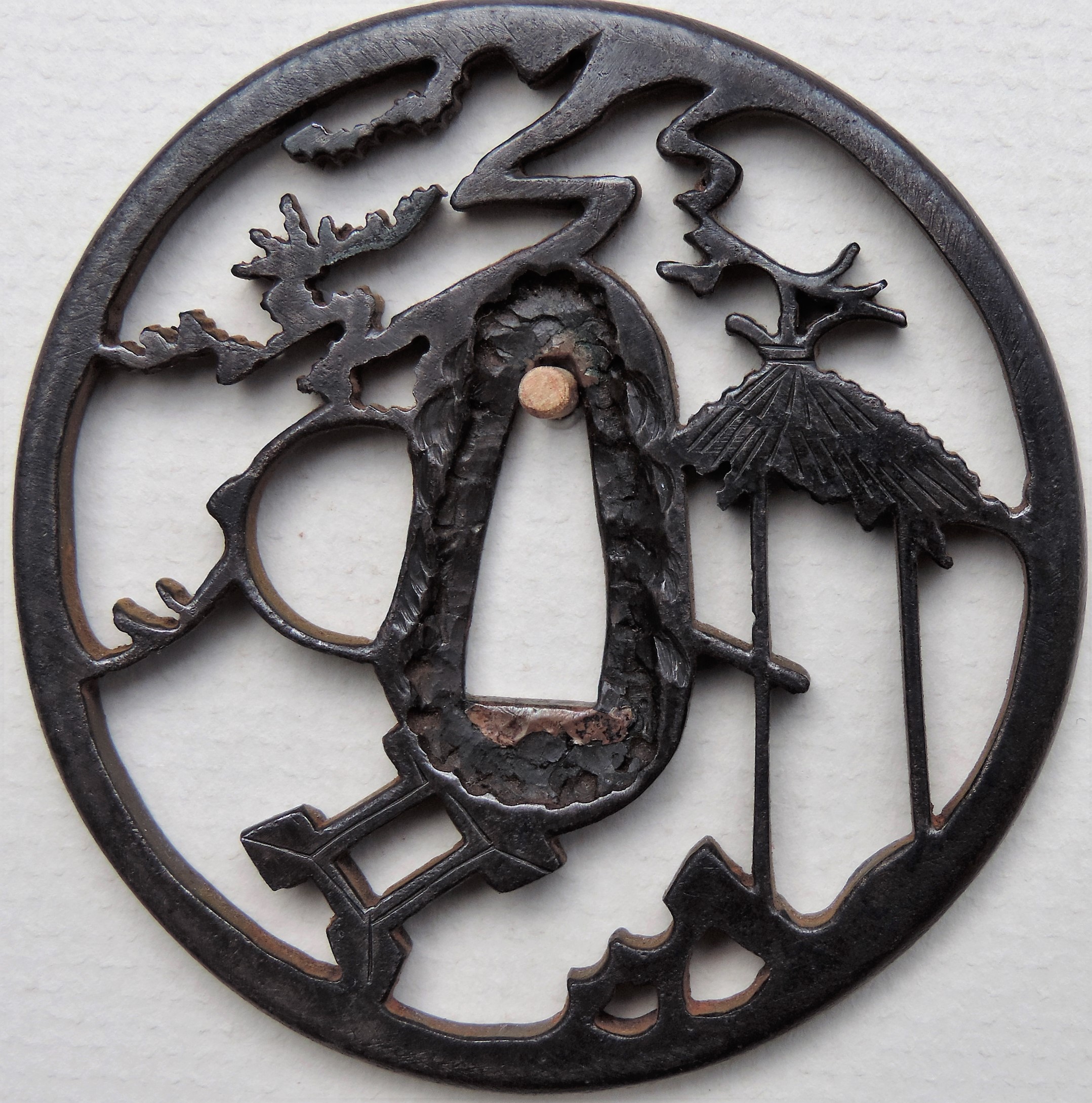 |
Akasaka $1800.00 "A large late Edo period (ca.1800) Akasaka tsuba with excellent black patina and fine tekkotsu. Highly forged iron is used; the hitsu-ana and seppa-dai are very well formed. The shape of the hitsu-ana can be classified as the work of the seventh master and the fourth Tadatoki (H 09168.0). The excavation of the seppa-dai was used by the samurai to conceal something of value, a prayer or gold.The imaginative concept and surprising design are testimony to the great genius of this Akasaka master portraying the energy of the school. A roof made of bamboo and the rectangle shape representing a framed plaque containing an inscription normally hung over a doorway, are two examples of Akasaka motif." (Long) 8.23cm x 8.39cm x 0.52cm |
DAI SAOTOME POA |
|
  |
SAOTOME KO SAKU $3300.00
"An excellant, strongly forged iron ground Saotome tsuba with sukashi of two family mon design. Probably the prized tsuba of a very skilled samurai. The Saotome school originates from the Myochin school, and were very skilled at producing superior iron and iron tsuba." (Haynes) 7.85cm x 7.52cm x 0.28cm |
  |
SANADA TEMBO $1000.00
"Scattered tsuba with iron mallet joint round inlay, unsigned, one hitsu filled. It is a blunt and artistic fukiyose brass inlaid tsuba. I think it's Sanada Tembo because it's made in a different place and has letters stamped on it. There is an explanation on page 15 of "The Beauty of Japanese Tsuba" by Arthur H. Church. Although there are stains, and rust over time, it is a gem with an old-fashioned taste." (Haynes) 8.39cm x 8.24cm x 0.45cm |
 |
'ODAWARA SUMI SAOTOME IESADA' $7500.00
"Iron mokko form plate with well hammered surface. Fine iron bones appear on the rim edge. This Saotome school work shows the very best of this important school with the quality of the iron plate, the very fine hammer work, plus the excellant design. More of this write-up to follow. This example was made about ca 1450-1500." (Long) 8.60cm x 9.50cm |
HIGO TSUBA
SHIMIZU-JINGO TSUBA |
  |
'SAN DAI MEI' 'AGE 72' (Yatsushiro) $5000.00 "Presented here is a fine example of the work of the 3rd YATSUSHIRO of the Shimizu Jingo family. His work shows the style and quality of his period and not that of the first or second Jingo. He was a retainer of the Hosokawa Daimyo from the age of 15, and it is said, became head of the family in 1710, at the age of 20." (Haynes) |
  |
'YATSUSHIRO JINGO SAKU' $1500.00 "Presented here is a fine example of the work of a later generation of the Shimizu Jingo family. The inlay of the dragon is complete and very well done. On the reverse is a Buddhist Vagra. Dr. Torigoye Hakogake dated 1956, designates this tsuba as 2nd Class." (Haynes) |
 |
CHISOKUTEI JINGO $1500.00 "An oval form tsuba, bearing a ground of stamped kokuin of flowerheads and engraved with a hawk and captured monkey. This design is of the JINGO family of the Shimizu school. It dates ca. 1700. This appears to be the work of CHISOKUTEI H 00315.0. He is of the Shimizu family and worked in Yatsushiro in Higo Province. He worked in the style of classic early Shimizu Jingo school. His relationship to the other members of the school is not known for sure. His work is equal to his contemporaries." (Haynes) See Wakayama Takeshi; Toso Kinko Jiten, pg. 500 & Toso Kodogu Meiji Taikei, vol. III pg. 313. 6.5cm x 6.95cm x 0.5cm |
  |
CHISOKUTEI JINGO POA "Write-up to follow" (Long & Haynes) |
 |
SHIMIZU JINGO $1200.00 "Worked in Yatsushiro in Higo Province." (Long) Under study at this time." (Long & Haynes) 6.50cm x 7.20cm x 0.40cm. |
 |
JINGO Style, HIGO Tsuba POA "A large iron plate tsuba in aoi-jujigata mokko shape. The single hitsu-ana is rectangular in shape. Extending outward from the hitsu-ana are leaves, inlayed of brass. On the opposite side is a 'Thunderfish' inlayed of copper. Under study at this time." (Long & Haynes) 8.50cm x 7.80cm x 0.30cm |
   |
JINGO $4500.00 "A very noble iron plate tsuba belonging to the JINGO school. The iron is radiant, appearing wet in hand. The hitsu-ana are designs of gourds, being different shape and size. Because of the highly refined simplicity of the design and high quality of the iron surface, this is a 'classic' Jingo tsuba. Seems to date to the early Edo period." (Long) 7.55cm x 7.12cm x 0.45cm |
NISHIGAKI KANSHIRO TSUBA |
  |
Nishigaki Kanshiro $3000.00 "A classic design by 2nd. generation Nishigaki Kanshiro. See Haynes Index H 02673.0.
Accompanied with a Dr. Torigoye Hakogaki dated 1957." (Long) |
   |
KUMAGAI $4000.00 "The theme of this tsuba is Dragon and Clouds. An iron plate in mokko shape with details in gold. Dates to Mid Edo period. The Kumagai tradition was founded by Kumagai Yoshiyuki and worked as the official craftsmen for the Higo Clan in Edo. This tradition became popular and flourished based on the Higo Tradition and the use of their own techniques." (Long) 8.70cm x 7.90cm x 0.40cm |
  |
KUMAGAI FUJIEDA $1500.00 "Write up to follow." (Haynes) |
  |
MASATOSHI $2000.00 "Presented here is a perfect example of the work created by MASATOSHI, the younger brother of KAMIYOSHI RAKUJU. It is a beautiful iron masterpiece with very finely carved fronds creating the shape of the tsuba. He worked mostly in the style of RAKUJU but never signed his work." (Haynes) |
 |
HIGO Tsuba $2000.00 "Iron sukashi Higo tsuba, with a classic Tsuru or crane motif, carved 'in the round', with outspread wings enclosing over its head. Details of the head, feathers and cross-hatching on the seppadai, are finely carved into the plate, and prominent eyes are inlaid with brass. Two large udenuki-ana holes detail the bottom of the tsuba." (Long) 7.72cm x 7.39cm x 0.50cm |
  |
'TSUGUYOSHI SAKU' $2000.00 "An iron plate in aorigata shape with dote mimi. The theme of the entire piece is 'Dragons in the Clouds'. It was believed that the Dragon was the bringer of rain and good opportunity. It usually lives in the water, but when the time has come, it makes the sky cloudy, causing it to rain as it rises high into the sky. This motif made the Dragon a symbol of a successful leap and it was sometime used as the symbol of an Emperor. The entire piece covered in gold nunome inlay. The dote mimi at one time completely covered. Signed: 'TSUGUYOSHI SAKU'. Haynes Index H 10770.0. A member of the Tani family school of Higo." (Long) 7.10cm x 7.70cm x 0.40cm |
 |
HIGO HIRATA $800.00 "Iron plate tsuba in mokko shape with tsuchime ji, a rough surface resembling the natural surface of stone. This creates an air of dignity, and refinement. The entire edge of the guard covered with a shakudo fukurin for artistic value or to hold missing plates on both sides. It is very rare to find a tsuba with a ryo hitsu-ana small enough that it must have been for an Umibari. There is a copper pillow in the larger hitsu-ana. Dates to Muromachi period, ca. 1500." (Long) 70.1mm x 64.7mm x 3.3mm (seppa) |
UMETADA HA
  |
'JOSHU NISHIJIN JU YOSHINAGA' $1900.00 "Presented here is a round shape iron ground tsuba of tortoise shell design. Intricate gold inlay of foliage in a scattered pattern. Signed: 'JOSHU NISHIJIN JU YOSHINAGA' a master craftsman of the Umetada family ca.1700. Illustrated in ZABO TANZEN, pg. 269, no. 319. Haynes Index H 11916.0." (Long) |
  |
'UMETADA' $2800.00 "The Umetada school first appears in the Tensho era (1573), its pre-existence unexplained.It is necessary to begin the study of the Umetada with the first known, and greatest master, MYOJU. One would expect that such a great artist would have a well defined genealogy and a brilliant family history, but just the opposite is the case. It is unfortunate thatn the foundation and origin of the talent of MYOJU is one of the great mysteries in the history of tsuba." (Long) |
  |
'TADATSUGU' $4800.00 "Iron plate in marugata shape, one hitsu-ana in suhama-gata filled with lead with sekigane. The sukashi design in positive silhouette of Daruma 'sitting in front of a wall'. The meaning of the upper left kanji is 'faith' (men) and the lower left kanji is 'wall' (heki). This depicts the Daruma as he sat silently wasting away in meditation. Signed: 'TADATSUGU'. H 09190.0. The delicate subject, careful finish and refined iron establishes this tsuba as a work of perfection." (Long) |
  |
'UMETADA TACHIBANA SHIGEYOSHI' $4200.00 "A maru gata iron sukashi guard of five kiku flowers that are very well carved. Appearing on the rim is a scroll design done in very fine gold nunome. MEI: 'UMETADA TACHIBANA SHIGEYOSHI'. This was the Shigeyoshi who was said to have taken the Umetada school from Kyoto to Edo. Comes with hakogaki by Dr. Kazutaro Torigoye." (Long) |
  |
UMETADA $1300.00 "Iron tsuba with brass fukurin, design motif of clouds and mist inlaid with brass." (Long) NBTHK Hozon origami. |
  |
KO UMETADA Serious Inquiries Only "The metal parts of the four-petal flower design are full-bodied, the design has movement, and the metal is of fine quality and has a deep color. These traits and the aged look of the seppa-dai and the hitsu-ana indicate that this is a work of some antiquity. The elegance of the design is distinctively Umetada. Dates to Muromachi period, ca. 1500." (Long) |
 |
'UMETADA SHICHIZAEMON TACHIBANA SHIGEYOSHI' $1600.00 "Large squared circular (okaku maru) iron plate with design of peony flower and bud. Signed: 'Umetada Shichizaemon Tachibana Shigeyoshi'. Ref. Haynes H 08573.0. Took the Umetada school from Kyoto to Edo." (Long) |
 |
KO - UMETADA $5000.00 "Iron ji-sukashi tsuba with a design of a bridge for Koto. 'Nobility' is the keyword to describe this design. It is aesthetically satisfying in every detail. The surface of the plate is splendid and appears to be a little wet. The luster of the patina is in tune with the softly structured surface. Wonderful tekkotsu is to been seen in the rim.Dates ca. 1500-1550." (Long) |
|
KAGAMI-SHI POA |
|
  |
KAGAMI-SHI $5000.00 ""Mountain copper mokko shape carved of white radish leaves, one of the seven herbs of spring. Much of the black lacquer still remains. At first glance, it looks like the work of an old metalworker, but it is thought that it expresses the aesthetic sense of the third of the seven philosophers of Rikyu. Having gone through numerous battles, the state of 'wabisabi' has deepend more and more." (Haynes & Long) |
|
KAGAMI-SHI $2000.00 |
|
|
KAGAMI-SHI $2000.00 |
|
|
KAGAMI-SHI $3000.00 |
|
|
KANAGU-SHI $2000.00 |
|
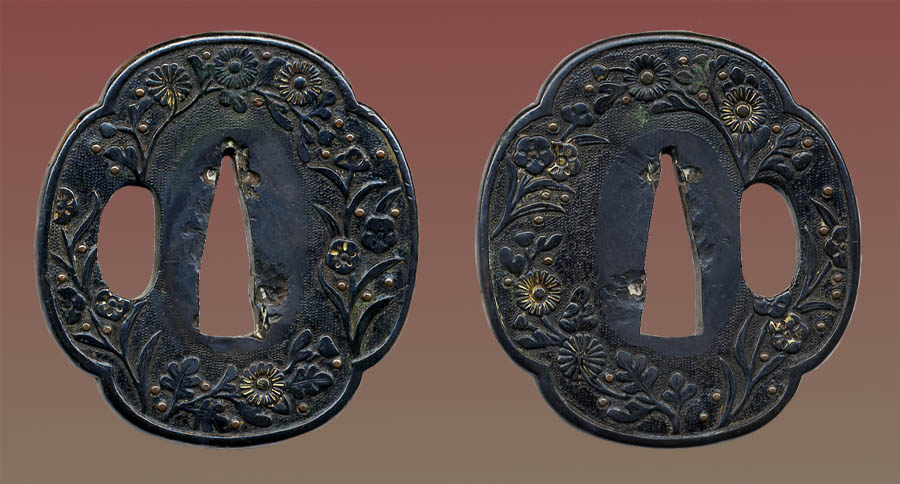 |
KO - KINKO $1500.00
"Accompanied by a Hozon certificate number 433796, issued by the N.B.T.H.K. "Mumei and attributed to Ko-Kinko. Momoyama period, ca.1450-1500. A Mokko-gata tsuba with thin shakudo plates covering both surfaces. Autumn flowering plants are represented with ten-zogan and iroe. The rim is covered with Shakudo-yakitsuke fukurin." (Long) 6.46cm x 5.94cm |
 |
KO-KINKO $3000.00 "Dates to mid Muromachi period. Write-up to follow." (Haynes) 7.25cm x 8.15cm x 0.25cm |
|
MIZUSHINKO MASAHIDE (seal) $500.00 |
BUSHU/CHOSHU TSUBA
  |
'BUSHU JU MASATOSHI' $1500.00
"Iron ground circular plowed hair carving, small openwork slight gold inlay. The shape of both hitsu are also unique and interesting, matching the grain of the cedar." (Haynes & Long) 7.51cm x 7.22cm x 0.55cm |
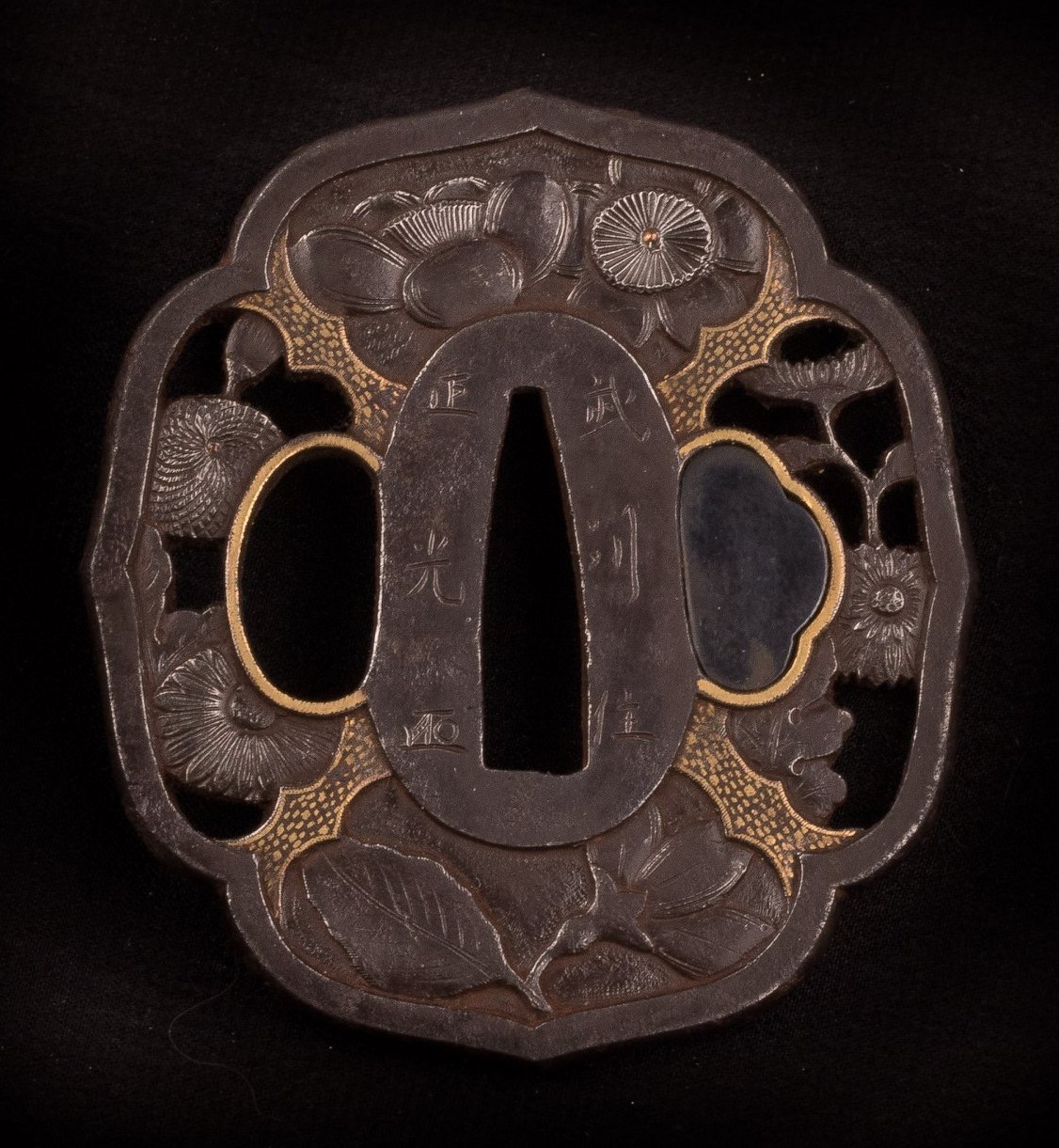 |
BUSHU JU MASAMITSU and Kao $800.00 "A very elegant iron plate tsuba in aoi gata shape. Various plants are finely carved in both positive and negative sukashi. At the four cardinal points are stems with inlay of gold. Both hitsu-ana are outlined in gold also. Mei reads 'BUSHU JU MASAMITSU'. There were a number of Masamitsu artists that worked in Bushu, which one made this is unknown. The Kao is unrecorded." (Long) 6.15cm x 6.80cm x 0.40cm |
 |
"CHOSHU HAGI JU KAWAJI SAKU" $2000.00 "A very elegant iron plate DaiSho set in marugata shape. Various cherry blossoms, both in negative and positive sukashi, are finely carved. Mei reads "CHOSHU HAGI JU" "KAWAJI SAKU". Refer to Haynes H 02969.0. Done by a family member in ca. 1800. Which family member is unknown." (Long) Dai: 7.50cm x 7.60cm x 0.50cm. Sho: 7.00cm x 7.30cm x 0.50cm. |
 |
CHOSHU TOUSEN Tsuba $700.00 "Iron mokko shape tsuba. The subject is a pair of "Morukoshi-fune", or "Tousen", or Chinese ships. The term was liberally applied to all foreign ships. Under Sakoku edicts most of Japan was cut off of foreign trade. Some Nagasaki carvers, like Onitake Toshiyoshi, were also known to have worked in Hagi, Choshu. They would have seen Chinese ships tied up at the docks, and Dutch vessels riding at anchor in the harbor. Seems likely the image was copied from a print." (Long) 7.70cm x 8.20cm x 0.32cm |
MITO School
 |
'KATSUNOBU' $800.00 "Iron plate of rounded oblong shape with a slight raised rim and hammered mimi. The face with Mt. Fuji and two gold butterflies, and a carved poem. The back with a silver cresent moon and gold cherry flowers. The face is signed: 'Shishido ju' (probably in Mito Prov.) and on the left: 'Shigyo Saku', which would seem to mean "I made this work as a gift." On the back is: 'Oshoku Tadayuki ko' which means, made to the taste of Mr. Oshoku. On the left of the back is: 'Mito ju KATSUNOBU'. An unrecorded artist that now has the number H 02848.B. All of this inscription is very unusual and it would seem that this was a very special order work and probably between friends." (Haynes) 6.80cm x 7.45cm x 0.45cm (rim) |
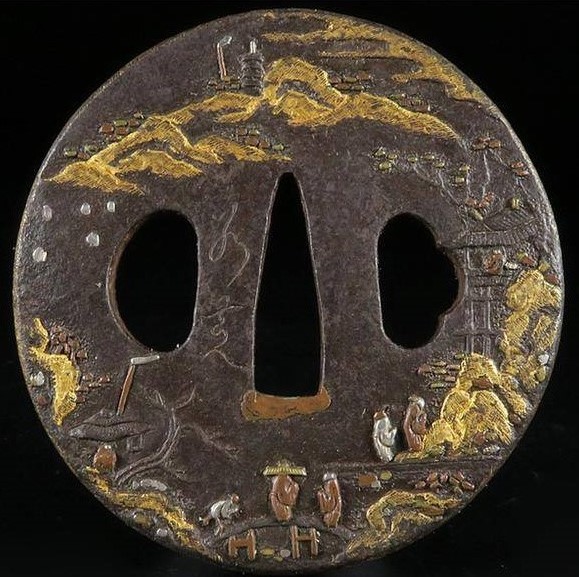 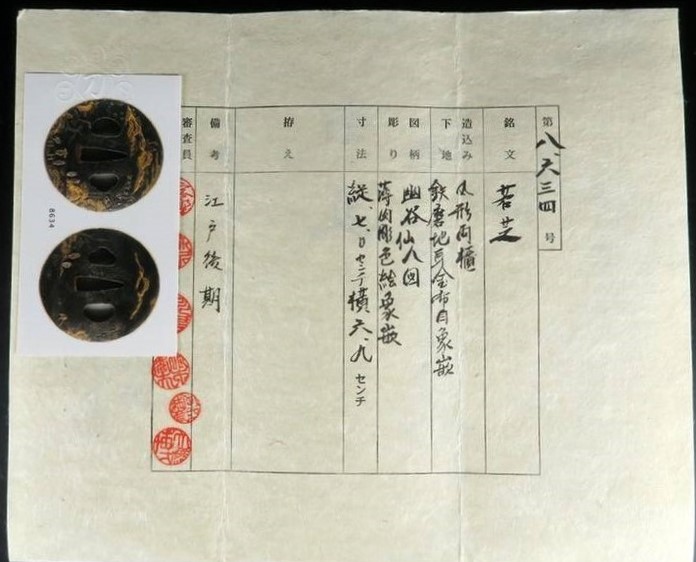 |
'JAKUSHI' $1800.00 "This piece illustrates the powerful influence of contemporary Chinese Nanga Literati painting. The use of soft metal (copper, gold, silver, shakudo) inlays to portray foliage, mountains, architecture, and human figures is consistant with the best workmanship of the Jakushi masters, Koreyuki and Koremitsu. The entire piece displays a high level of artistic refinement and sophistication. Exemplary Jakushi school tsuba, signed with two characters. One of the many examples of the sosho signature of the Jakushi family school. They lived and worked in Nagasaki of Hizen Province. Accompanied with NTHK origami." (Long) 6.85cm x 7.10cm x 0.55cm |
  |
'JAKUSHI' $2500.00 "This piece exemplifies the powerful influence of contemporary Chinese Nanga Literati painting. The use of soft metal (copper, gold, silver, shakudo) inlays to portray mountains, architecture, and human figures is consistant with the best workmanship of the Jakushi masters, Koreyuki and Koremitsu. The entire piece displays a high level of artistic refinement and sophistication. Accompanied with NBTHK origami."(Long) 6.95cm x 7.25cm x 0.41cm |
  |
'JAKUSHI' $1300.00 One of the many examples of the sosho signature of the Jakushi family school. They lived and worked in Nagasaki of Hizen Province. Accompanied with NBTHK 'Green' origami. 7.00cm x 7.20cm x 0.50cm |
 |
HIZEN $1000.00 A presentation tsuba of mokko shaped iron plate covered with fine karakusa carving on both faces and the rim. There is an internal border just inside the rim of the same mokko shape, both sides. Also appearing are seven mon on the omote and three mon on the ura. 7.10cm x 7.73cm x 0.49cm |
 |
HIZEN/KIRIFUMI work $800.00 A very nice example of Hizen work dating about ca. 1500. The design is of 'Chinese Good Luck Objects' which is seen often from this area. The Katchushi-style plate is of this same period, ca. 1500. The rectangular hitsu are typical of Hizen work. 7.51cm x 7.38cm x 0.55cm at seppa-dai. |
  |
HIZEN/SAGA KANEIYE work $1400.00 "This fine iron tsuba for a Japanese sword has a maru gata circular form, with sekigane in the nakago ana, a look of great strength and a well patined surface. It has a filled kotzuka-ana. The well patined surface is carved in a delicate manner in katakiri bori on both faces. The subject depicts a peaceful landscape, with two Tsuru alighting above, and mountains rising in the distance. The design looks like a painting, it is in the tradition of Chinese Sung dynasty landscape painting, and of the ink drawings of the Japanese painter Sesshuu. 7.45cm x 7.65cm x 0.49cm (rim) |
 |
HIZEN/NAGASAKI work $500.00 Edo era iron plate with carved wave design on both seppa-dai. A very large uchikaeshi rim. The plate is well-hammered to an almost polished finish. The finished plate was then placed inside the large rim. The piece is crafted very well. 6.63cm x 6.45cm x 0.40cm at seppa-dai, 1.40cm rim width. |
MINO School
  |
'KANEHISA' $1000.00 "Iron maru-gata shape tsuba with maru-kaku mimi. A very rare Mino swordsmith tsuba by Kanehisa who was the son of Nao Shizu Kanetoshi during the period of the Northern and Southern Courts. Certificate of Authenticity from NBTHK. Hozon Tosogu." (Long) 8.60cm x 8.50cm x 0.40cm |
 |
MINO BORI or EZO UNDER STUDY "Early Mino work often depicts gardens and insects, in deep relief, bringing to mind that the world is beautiful, yet risk is ever present. A rare Mino Bori tsuba with design of cricket and chrysanthemums on both omote and ura. An iron plate of rounded square shape with gold gilded copper overlays. The fire gilding attaches very well to copper but not iron. The marks on the right side of seppa-dai have unknown meaning. 6.40cm x 6.80cm x 0.5cm Dates to the Momoyama period." (Long) |
'SANKEI'
KAZUTSUNE (H 03052.0)
 $1200.00 |
SHOKOKU Tsuba
 |
'NAOMITSU YANAGAWA' $3000.00 "An iron plate (tetsu-ji) in 'Sumikiri Kaku' shape (square with slightly beveled corners). Motif of chrysanthemums floating on the water appear on both faces. Described in Japan as: Tetsuji Kikusui no Zu Otsuba Sendai. Inscription by Naomitsu Yanagawa, Senfu. This is Haynes H 06717.0. He was the adopted son and student of Yanagawa Naomasa (H 06695.0). He was a silversmith in his youth with the name of Koemon. At age 25 he took the name Sanzaemon. He was a retainer of the Soma Daimyo at Nakamura in Iwaki Province. According to what is written, this tsuba was ordered by Hou Date, the lord of the Sendai domain. "Osenfu" is engraved" (Long) |
   |
"EFU JU TSUNEYUKE" $4000.00 "Oval shape iron plate tsuba with intricately carved clouds, and the constellation of the 'Big Dipper' with a Ken at the end of the handle. On the omote, appears a bat that has gold inlay on the tips of wings and is also very well carved. There are hitsu-ana, the kogai-ana being filled with lead. Signed: 'EFU ju TSUNEYUKI'. This is H 10950.0 in Haynes Index. 7.05cm x 7.35cm x 0.35cm |
  |
'YOSHIHISA' & Seal $5500.00 "A masterpiece by YOSHIHISA. Art names: BUNSUKE, TASHICHI, YOSHINORI. See Haynes Index H11643.0. Unknown writer of Hakogaki. Published in ZABO TANSEN, pg. 212. An iron plate with two dancers inlaid with gold, shakudo, and copper. The lively expression brings out the movement of the dance." (Long/Haynes) 7.40cm x 7.20cm x 0.40cm |
  |
KUTSUWA-GATA $2400.00 "Kenkyusha's NEW JAPANESE-ENGLISH DICTIONARY (Copyright, 1954) defines 'kutsuwa-gata', a Greek cross in a circle." (Long/Haynes) 7.61cm x 7.60cm x 0.61cm. |
  |
'IKEDA KAZUHIDE' $3000.00 "It is a rare tsuba that shows a special tempered skin which may be called 'crepe' forged skin. The first person who trained in this work was the son of the famous swordsmith Ikeda Kazuhide (2nd Gen.) of the Shonai clan, and according to the inscription, he was also a gunsmith. Perhaps this unique and unusual tempered skin is the result of the application of gun manufacturing techniques and iron. The large mokko shape is hammered back with uchikaeshi rim, and the face is placed thickly so that it surrounds to form a circular phase. This is a design associated with the spirit of Zen and is considered to symbolize truth and enlightenment. It is also said to manifest a state of continuous flow without beginning or end, that is, a liberated mind." (Long) |
  |
|
 |
'SEIRYUKEN EIJU SAKU' and Seal. $2000.00 "Presented here is a set consisting of a tsuba and fuchi/kashira of iron. All pieces have a chiseled decor of plants. The style and quality of this set displays the high artistic ability of NAOFUSA. The signature on both the tsuba and fuchi read 'SEIRYUKEN EIJU SAKU'. He often signed his masterly pieces in beautiful cursive sosho (grass script) followed with a gold inlaid seal. This was the art name of NAOFUSA (H 06602.0). He was a student of Okamoto Harukuni (H 00810) and the adopted son of Okamoto Naoshige (H 06772)." Attributed here with a Hakogake by Dr. Torigoye." (Long) |
 |
KASUGA SCHOOL $850.00 "Jiyu-gata (free-shaped) iron plate tsuba with the web carved with a design of a plum blossom branch. This example is remarkable in the very fine kebori carving and attention to detail. The center of each plum blossom is iron-on-iron inlay, four on the omote and five on the ura. It is possible that the thickest part of the branch on both sides has iron-on-iron inlay. In all respects, this is one of the finest examples of this school. Dates to ca. 1700-1750." (Long) 8.40cm x 8.60cm x 0.38cm (seppa). |
 |
HORAI Design $2500.00 "Round (maru gata) iron plate tsuba with kebori carving of 'Horai Tsurukame', the symbolic design of the Horai family. The rim shape from a crane with spread wings and a minokame (mythical turtle) with bearded tail. Dates to 1800. All in all a very fine work by a very adept artist." (Haynes & Long) 8.05cm x 8.07cm x 0.50cm (seppa) |
  |
'MINAMOTO MASAKUNI' $2000.00 "The theme of this tsuba is Dragon with Waves and Rocks. The work is signed with a long signature (see translation below). This craftsman's work can be found around 1779, Mid Edo Period. It is valuable as a historic item. There is not a lot written on this craftsman yet, but on this tsuba there is a lot of good information about him." (Haynes & Long) 6.40cm x 5.90cm x 0.40cm |
|
KARAHANA |
|
|
IWATA NORISUKE |
|
|
SANSUI-GA |
|
|
European Tea Kettle Design |
|
|
'YASAKA EIKAN SAKU' |
|
|
'YASUTSUGU' $600.00 |
|
 |
'MUNEMASA' with Kao
$700.00 "Irregular oval iron plate with smooth surface, and slightly raised rim. Hot stamped with the design of the symbols for the five mountain ranges of China. With original copper plugs at top and bottom of the nakago-ana, both with small chrysanthemum stamps on both sides. Udenuki appear in lower right quadrant. Signed: 'Munemasa' with kao, H 06130.0.This is the artist who lived in Hisai in Ise Province. Born 1817, died June 25, 1863." (Haynes & Long) |
 |
'TSUNETOSHI'
$900.00 A large and heavy iron mokko-gata shape tsuba for a very large Katana. The forging is extremely well done showing multiple folds in the steel. The hammer work is advanced, especially in the shaping of the rim. The sukashi in the lower quadrant is of landscape terrain and water. And two cranes above deciding where to land. This is very reminiscence of Kaneiye work. The signature that appears in the lower, right area, is of 'TSUNETOSHI' of the Miyaguchi family (H 10920.0). He was a swordsmith that made his own tsuba. (Haynes & Long) |
SOFT METAL (KINKO) TSUBA
KO-KINKO, (Ko-Mino, Ko-Goto), and KINKO Tsuba
|
'JOI' 'Sensei' |
|
'BUJO AKASAKA INSHU RAKU JOI NAGAHARU TSUKURU' |
  |
$10,000.00 "A large round copper plate of katana size with the face showing Hotei riding on a horse, that looks much like a mule, or perhaps a Mongolian pony. His staff and fan are carved and inlaid on the reverse side. The plate surface is ishime of very fine grain. The horse, robe and staff are in pure shishiai style. The head, body and arm of Hotei are above surface inlay, as is the fan on the reverse side. The clouds are carved well below the plate surface and have gold inlay touches and a silver moon on the back side. The amount of detail carving is hard to see in some cases, as it is so fine. The quality of this tsuba is far superior to that of many others with this same subject, and shows the true ability of the work of Joi. Read complete descriptive article by Robert Haynes titled 'The M. Arthur Kay Sugiura Joi Tsuba HERE. |
|
'JOEI' 'Student' |
 |
'JOEI' $4000.00 |
 |
'JOCHIKU' $10,000.00 |
 |
'ISSAI TOMEI' & Kao $7500.00 |
|
'MITSUNAGA' (Nidai) $5000.00 | |
|
''ISHIYAMA MOTOTADA SAKU'' $1500.00 | |
  |
'ISHIYAMA MOTOTADA SAKU' (H 05940.0) $3000.00 Provenance: Robert E. Haynes "A very fine shakudo ground with gorgeous gold inlay work and a gold fukurin. The delicately carved horses, autumn grasses and mushi are realistic and show a high degree of ability and expressiveness." 6.90cm x 7.25cm x 0.35cm. |
 |
'NAGATSUNE' & Kao
$2000.00 |
 |
'ECHIZEN no DAIJO MINAMOTO NAGATSUNE' & Kao
$7000.00 "A slight oval shakudo plate with precise nanako. Both hitsu-ana are present and shows signs of being mounted more than once. A gold fukurin adorns the piece. The design is of Bamboo ("Take") and Tigers ("Tora"). Since its introduction to Japan, the Tiger in the Bamboo had been a preferred picture for paintings and for metal carving and inlays. The design was both carved and made separate then attached. MEI:'ECHIZEN no DAIJO MINAMOTO NAGATSUNE' & Kao. H 06539.0. Summarizing, he studied painting under Ishida Yutei, was a student of Yasui Takanaga, and received the title of Echizennodaijo in 1770." (Haynes & Long) |
 |
"NAOKATSU" $3000.00 "A very fine shakudo plate with a delicate carving of a leopard frolicing in nature. There are various types of foliage and landscape on both faces. It is a very advanced work showing the delicateness of the carving of the leaves, flower buds and the leopards spots along with the rest of the design. Signed: 'NAOKATSU'. This is the son of Naoshige (H 06773) and a student of Yanagawa Naomasa (H 06690). He signed with both the Inagawa and Yanagawa family names and would use the same Kao with each, in some cases." (Long) 7.45cm x 7.65cm x 0.45cm |
  |
A STUDY of OX POA A study of OX themed tsuba done by three different schools and their interpretation. |
  |
'YASUCHIKA' (Seal) $3000.00 "This tsuba is of shakudo plate. The surface seems in various lights to have an almost serene quality about it. The plate is quiet and subtle in color and tone. The round shape plate has a smooth polished rim that goes over the edges. This style of rim is to be seen in other shakudo plate tsuba of this time, and sometimes they are of gold. The design on both faces are inlaid geese. The fowl on the front is highlighted in gold while the one on the reverse is inlaid in dark shakudo. Both have gold highlights. At the top on the front face is a silver moon. On the reverse is a gold inlaid branch and the 'Yasuchika' seal."(Long) 6.52cm x 6.18cm x 0.41cm |
  |
'SOHO' & Kao $2000.00 "Presented here is a rare gem of the YOKOTANI School. The tiger diagram on the omote and the bamboo forest on the ura are expressed in one-sided carving which is the family art of the Yokotani school. The base material is made day and night with shakudo and copper ground. The edges of the hitsu-ana and the rim are decorated with gorgeous gold rings. The mei reads: SOHO & Kao. This is H 08891.0."(Long) 6.50cm x 6.70cm x 0.40cm |
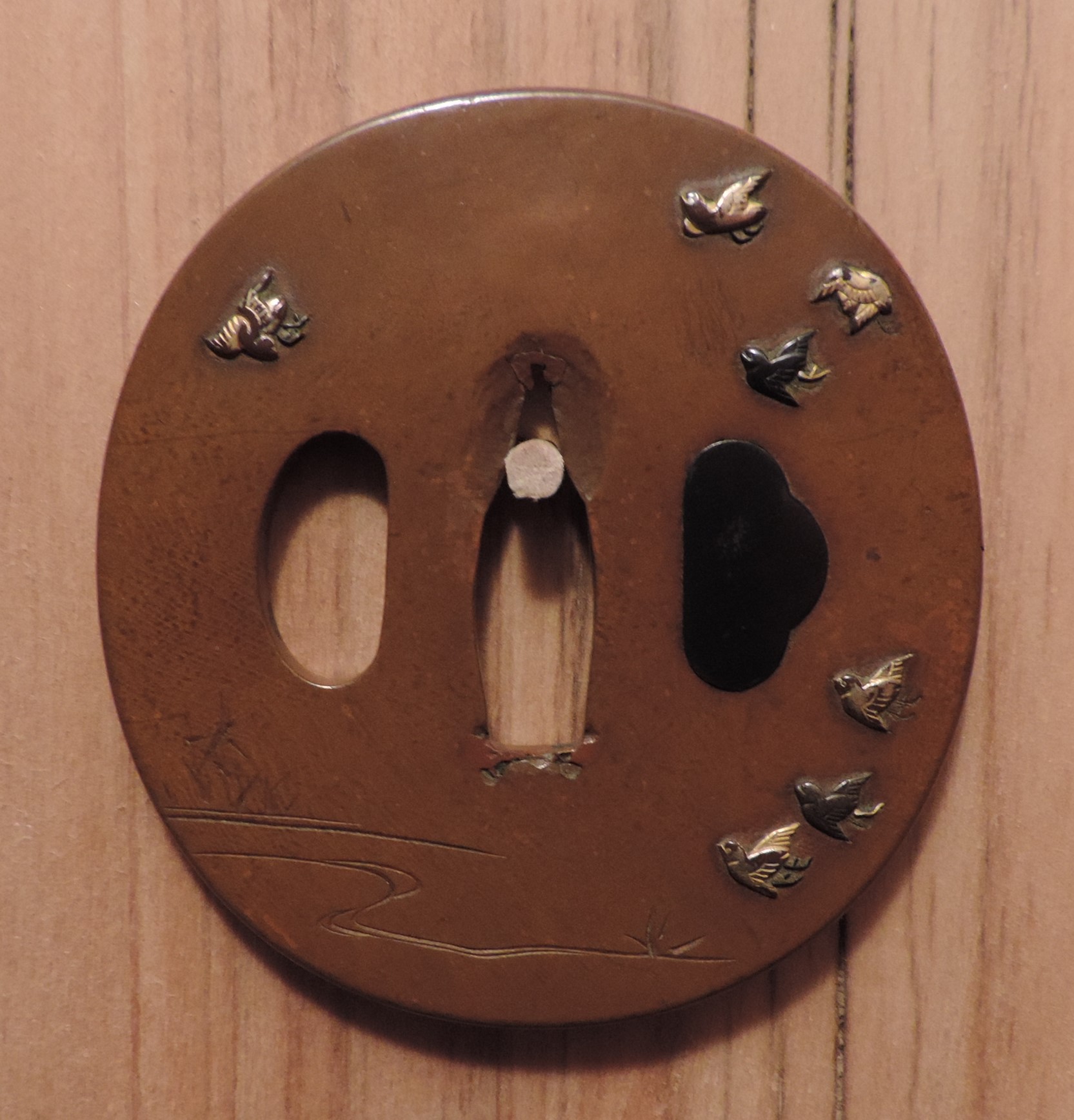 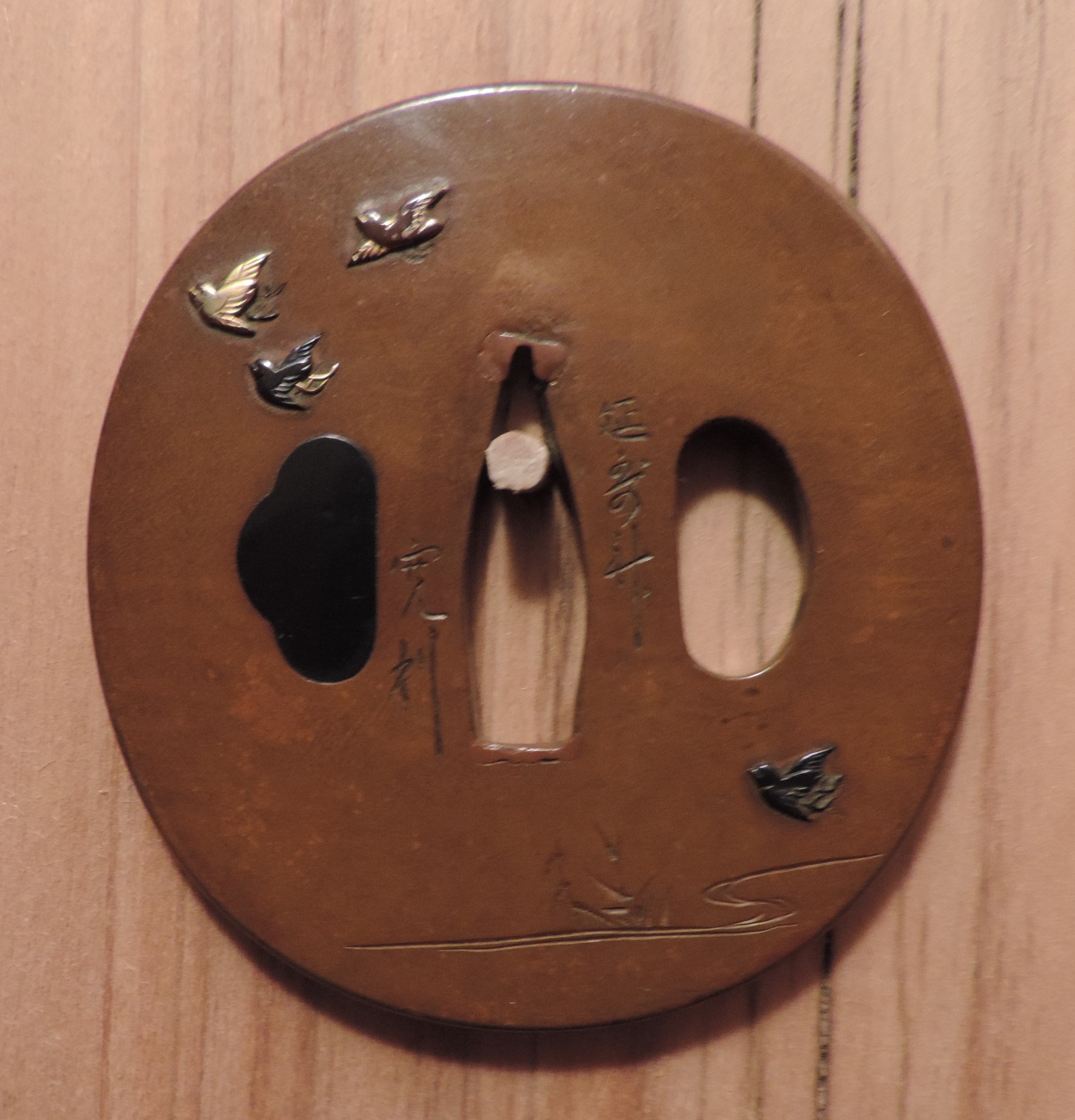 |
'ENJUSAI KANRI' $1500.00 Oval copper plate with original patina in perfect condition. The design is of 'Mura-chidori', a flock of plovers. There are seven on omote and four on the ura. The flock is flying over a stream. The plovers are in gold, shakudo, and copper. See Haynes Index H 02661.0. Accompanied with NBTHK Hozon #2002120.(Long) 6.20cm x 6.60cm x 0.35cm |
| NAGINATA Guard Serious Inquiries Only "Large round copper plate nicely forged and hammered with excellent patina and color. Further study and description coming soon." (Haynes & Long) | |
 |
'GENZAEMON KATSUHISA' & Kao $1400.00 "A copper base plate with the design of paulownia using the Katakiri-Bori technique. The rim is of shakudo. Mei: 'GENZAEMON KATSUHISA'. This craftsman, Kuwamura Genzaemon Katsuhisa, was born in 1694 and had the reputation of 'Joko'. He was the son of Kuwamura Morikatsu, who was a disciple of Goto Kakujo. See Haynes Index H 02774.0." NBTHK Certification. Hozon Tosogu. March 16, 2017. (Long) 6.60cm x 6.40cm x 0.50cm |
  |
KO - KINKO Under Study "Iron stone mokko shape, engraved carving on a very large tsuba that is imagined to have been used for the Odachi sword of the late Muromachi period. After more than 600 years, the iron has developed a unique texture, and the scattered engravings such as cherry blossoms, chrysanthemums, bellflowers, and crests have been beautifully preserved." (Haynes) |
  |
KO - KINKO POA "A slight oval shape shakudo kikka and fan motif, three fans depicted in positive silhouette sukashi set amid the petals of a partial 32-petal chrysanthemum on the ura. The petal surfaces are carved out sukidashi takabori and decorated with radiating lines of nanako. The omote is a surface design displaying more foilage including chrysanthemums, sakura, fern fronds and other plants on a background of nanako. The fans have iroe of 'worn' gold, kebori and nanako. The arrangement of fans and kiku is refined and very pleasing to enjoy." (Haynes) |
 |
KO KINKO $600.00
"The tsuba presented here is a wonderful soft metal example with delicate Amida yasurime. This term - Amida - is the name of ancient Buddhism and it is interesting to speculate whether this finish was originally intended to have a particular religious meaning, such as to signify its owner's faith. There are two identical hitsu and extensive punch marks around the nakago-ana." (Long) 8.00cm x 7.70cm x 0.30cm |
 |
|
 |
SENDAI KIYOSADA $3000.00 |
 |
MACHIBORI $450.00
"A brass diamond shape (otafuka) tanto-sized tsuba with a well carved symetrical design of two dragons chasing a jewel. This suggests a theme of Qing Sino-Tibetan design. Dating to late Edo period. History tells us this design originated in ancient Mesopotamia, and repeated on 6th century Silk Road textiles from Central Asia. Now described as KANTON tsuba, which designates goods imported to Japan by Cantonese merchants in Nagasaki." (Long) 5.60cm x 6.15cm x 0.35cm (seppa) x 0.75cm (rim) |
 |
'HOKURITEI RYOSAI' $1200.00 "Oval shakudo plate with design of a court official greeting traveling merchants. The rather high relief inlay is in gold, silver, copper, shibuichi, and shakudo. One should note the style of the eccentric trees and clouds which are either by this artist or from a wood block print. The remainder of the subject is seen on the reverse and all is under a rain covered sky. The face is signed: (in tiny kanji) 'Hokuritei' and 'Ryosai' with kao, (H 07603.0)." (Haynes) 6.15cm x 6.70cm x 0.30cm |
|
SANDO AWASE $800.00 |
|
|
SANMAI DAISHO $800.00 |
|
|
SAN DIEGO Style $600.00 |
|
'SEKIBUN' |
  |
'SHIGENORI' $2000.00 "A shakudo plate in oval shape with inlays of gold, shakudo and silver. This is a classic representation of 'Dai-koku-ten'. Dai (Great) Koku (Darkness) Ten (Dharmapala) in Vajrayana Buddhism was the Defender Deity of the Law of Buddhism. In Japan, this deity is considered to be the Deity of Agriculture, Commerce and of Wealth. Mei: 'SHIGENORI' & Seal. This is H 08428.0. His teacher was Yanagawa Naomitsu." (Haynes & Long) 6.70cm x 7.00cm x 0.25cm |
|
'SHIGETSUNE' |
|
|
SATSUMA Mon |
|
 |
SHONAI SHOAMI $650.00
"Brass plate with ishime surface and inlaid in shakudo, copper, gold, and silver with a design of a heron in reeds by a stream. The reverse with just reeds in the same metals. This is a classic example of the work of the Shonai Shoami school circa 1700. This type of tsuba was very popular at the time with the local samurai. It is very rare in the West to find this type of brass plate with the original patina intact. The plate has been fitted with a very fine shakudo rope design rim cover, which is probably original to the origin of this tsuba. As of now we do not have any signed examples of this type of work." (Haynes) 6.05cm x 6.30cm x 0.46cm |
 |
SHONAI $950.00 "Red copper plate with hot stamps of cherry flowers on both sides. Shakudo rim cover. A classic mid-Muromachi (ca. 1450) Tachikanagu-shi example. Appears to have been mounted several times." (Haynes) 6.35cm x 6.65cm x 0.45cm Rim |
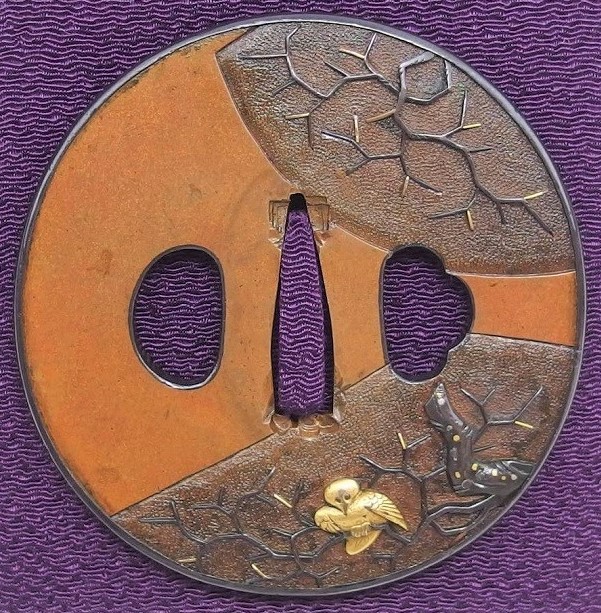 |
SHONAI-KINKO $2000.00 "A delicate soft metal plate of copper with shakudo fukurin and linings of both hitsu-ana. The areas of very fine nanako with branches of bamboo inlaid with dark shakudo, highlited with gold and with a few gold leaves. On the front face perched on a branch is a finely carved plover of gold whose eyes are inlaid with shakudo. The artist used a style of richness and splendor to create a masterpiece." (Haynes) 7.40cm x 7.65cm x 0.45cm |
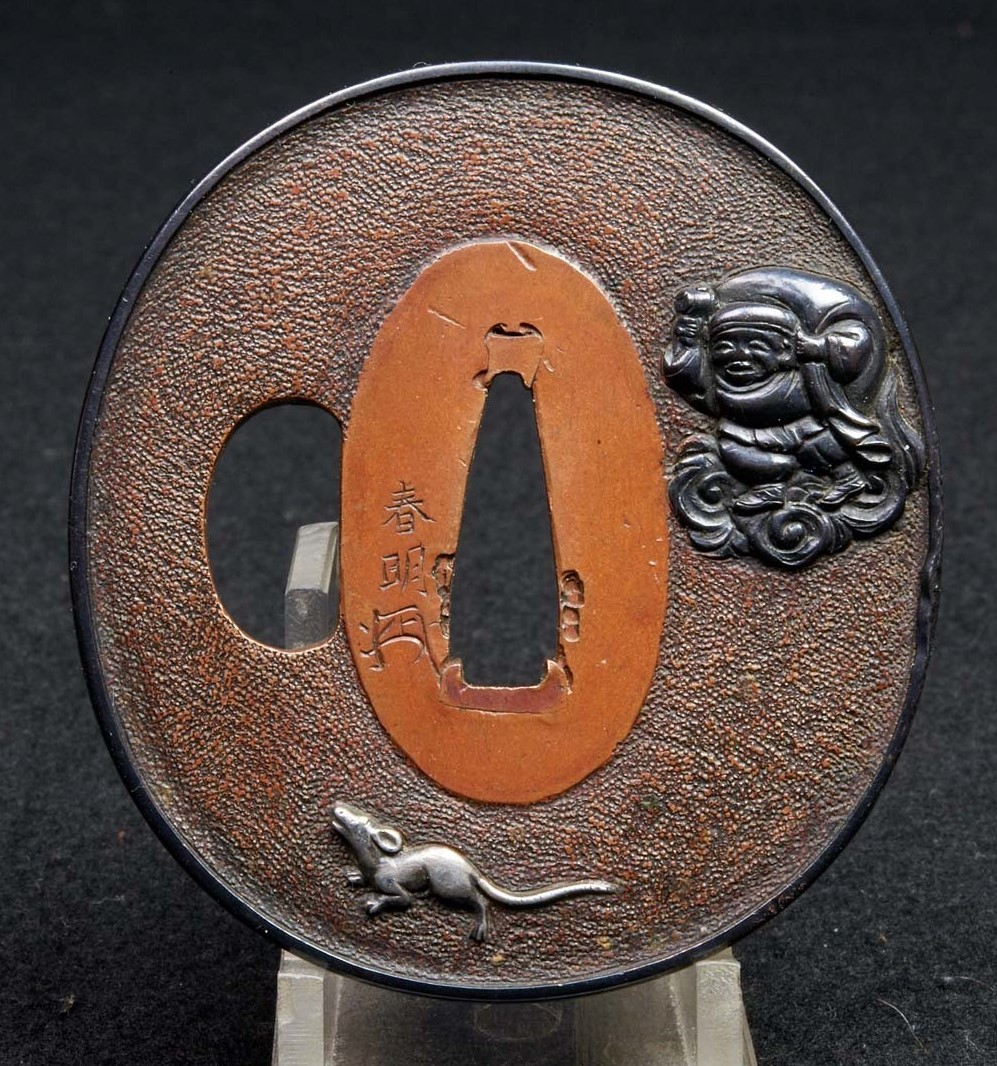 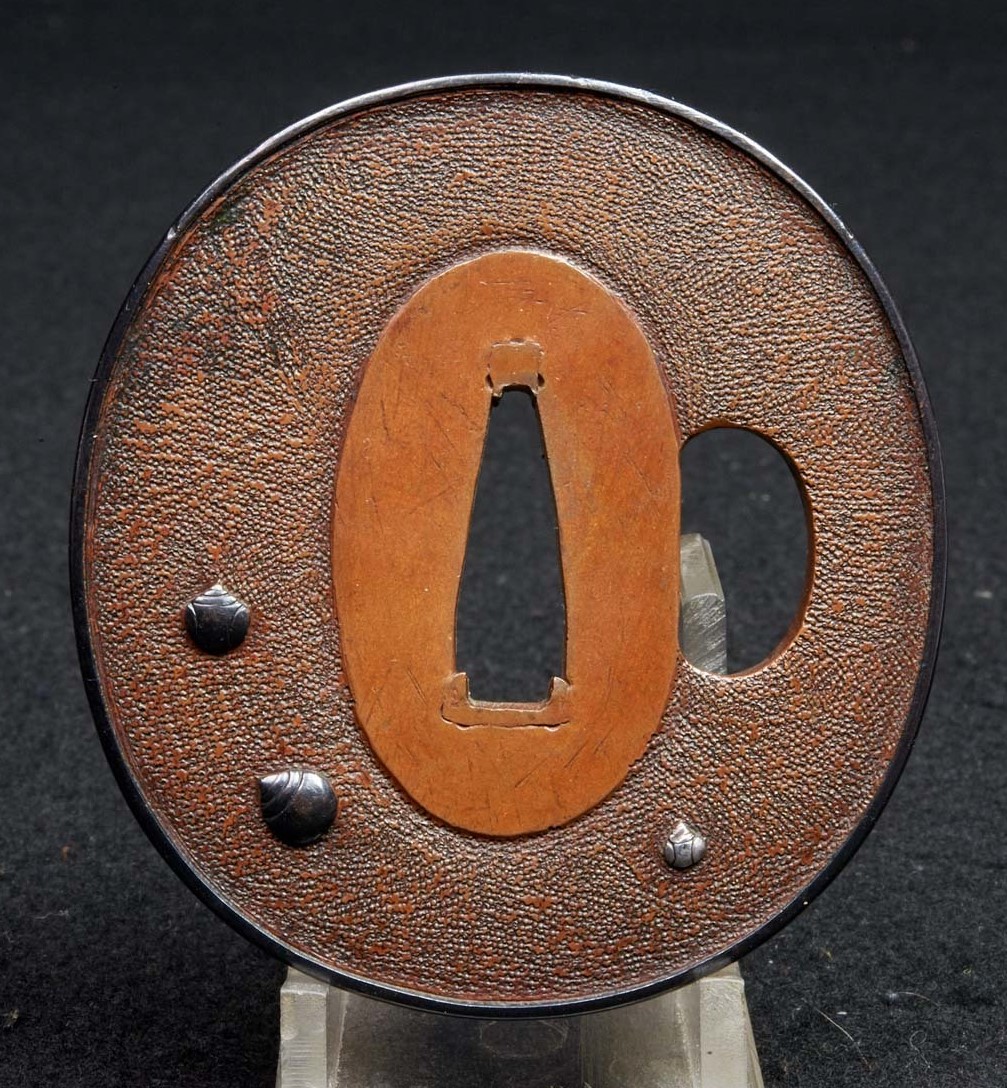 |
'SHUNMEI' $1000.00 "Slight oval, tatemaru gata, copper plate with shakudo fukurin. Finish of the plate, both sides are of chirimen ishime ji, or "silk crepe" finish. Appears as a very smart finish of exquisite taste, which was believed to have been originated by Murakami Jochiku and his school. Dates 1800 to 1850." (Long) 6.60cm x 6.10cm x 0.50cm |
  |
'SOCHI' $1500.00 "An oval shaped copper plate with very fine carving of 'Bukan' sleeping with his tiger next to a waterfall in the landscape. Bukan was a Zen monk and a poet who lived in the Tang Dynasty, and was known as a man of eccentricity who amazed people by riding around on his tiger. Mei: 'SOCHI'. This could be H 08860.0, of the Goto family ca. 1800. But further study is needed." (Haynes & Long) 6.50cm x 7.05cm x 0.40cm |
| If you would like to know more about any items on this website, or if you are considering a purchase, please send Elliott and Robert an E-MAIL ( elliott@shibuiswords.com ), asking us any questions you have or what pieces interest you. |
NIHONTO and TOSOUGU ORIGAMI
Schools of Tsuba Artists HERE
Tsuba Identification Guide HERE